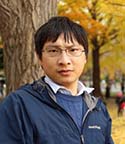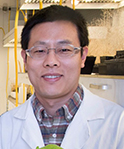Recognizing featured Plant Cell first authors, March and April 2017
Rakesh David, featured first author of Transcriptome-wide Mapping of RNA 5-Methylcytosine in Arabidopsis mRNAs and non-coding RNAs
 Current Position: Postdoctoral Fellow, ARC Centre of Excellence in Plant Energy Biology, University of Adelaide.
Current Position: Postdoctoral Fellow, ARC Centre of Excellence in Plant Energy Biology, University of Adelaide.
Education: PhD, Plant Molecular Biology, Plant Science Division, Research School of Biology, Australian National University, Australia.
Non-scientific Interests: Cycling, cricket, movies and reading.
My interest in the area of gene regulation first began during my Masters project in Bernie Carroll’s lab (University of Queensland, Australia) that investigated small non-coding RNAs as epigenetic regulators of gene expression. During my PhD study (Josette Masle’s lab, Australian National University), I further pursued my interests in gene regulation, this time focusing on a family of kinases critical to plant development and pathogen response. After graduating, I realized that in order to fully appreciate the intricate ways plants fine-tune gene regulation, I had to take a step back and tackle this issue at the transcriptome level. Fortunately, I had the opportunity to do this in Iain Searle’s lab (corresponding author, University of Adelaide) where I joined as a postdoctoral researcher. Iain was interested in post-transcriptional RNA modifications, particularly 5-methylcytosine (m5C), and sought to map this modification in the transcriptome of the model plant species Arabidopsis. Using bisulfite conversion and Illumina sequencing (bsRNA-seq), hundreds of m5C sites were mapped and a key enzyme mediating methylation of those sites, TRM4B, was identified. We showed that TRM4B is important in regulating cell division and the oxidative stress response, functions that are mirrored in orthologs of other eukaryotes, highlighting the conserved nature of m5C modification through evolution. I believe the field of RNA modifications or epitranscriptomics provides another regulatory layer of gene regulation, the implications of which are only beginning to be understood.
Lior Tal, featured first author of Coordination of Meristem Doming and the Floral Transition by Late Termination, a Kelch Repeat Protein
 Current Position: Postdoc in the research group of Prof. Yuval Eshed at the plant and environmental sciences department at the Weizmann institute of science, Israel.
Current Position: Postdoc in the research group of Prof. Yuval Eshed at the plant and environmental sciences department at the Weizmann institute of science, Israel.
Education: PhD (2016) in plant developmental genetic and M.Sc (2011) in plant genetics at the Weizmann institute of science. B.Sc (2008) in plant sciences at the Faculty of Agriculture, the Hebrew university, Israel.
Non-scientific Interests: Hiking, running, reading and spending time at the dog park.
As a third-generation farmer, I always felt like I was born with the love of plants. However I never saw myself as the type to wake up every day at dawn and work in the vineyards and orchards. During my undergraduate studies I learned that I am fascinated by plant genetics and developmental programs. Since than I spent my time researching basic genetic pathways in crops such as wheat, maize, and tomato that none of my ancestors ever grew. During my PhD studies I investigated known and novel genetic pathways by which tomatoes regulate flowering. This work included classic and new mapping techniques to identified unknown regulators of plant floral transition. One of these regulation pathways, described in this paper, characterized a novel late flowering mutant while revisited a research field “neglected” for half a century by using molecular tools. We show that meristem doming towards flowering, a widespread and conserved plant developmental process, can be driven by expression of a floral antagonist. Furthermore, we characterize a new kelch repeat protein that may act in transcription repression of such antagonists during meristem vegetative development. I am now looking forwards to my next research project and also am excited about the future of plant genetics and the creative ways by which basic science will be integrated with applicable science to improve world food production.
Young B. Cho, featured first author of Mutations in Argonaute5 Illuminate Epistatic Interactions of the K1 and I Loci Leading to Saddle Seed Color Patterns in Glycine max
 Current Position: Post-doctoral Research Associate, Ort Lab, USDA-ARS, Global Change and Photosynthesis Research Unit.
Current Position: Post-doctoral Research Associate, Ort Lab, USDA-ARS, Global Change and Photosynthesis Research Unit.
Education: PhD, Crop Sciences, University of Illinois.
Non-scientific Interests: Wife, family, friends, and Lionel Messi.
I remember a class in which my PhD advisor Dr. Lila Vodkin introduced her paper (Tuteja et al. 2009, Plant Cell) that described small RNAs regulating pigmentation of the soybean seed coat in a tissue-specific manner. She added it was still unknown why some seeds show spatial pigmentation patterns within the seed coat. I was intrigued by the pigment patterns and this paper (Cho et al. 2017, Plant Cell) addresses that question. My interests are in how sRNA is expressed and regulated in plants in tissue-, developmental stage- and pattern- specific manners so that it can be used more precisely as a tool to change plant traits. I am currently evaluating sRNA as a delicate gene regulation tool for optimizing photosynthetic efficiency of plants in Dr. Don Ort’s lab.
Sheliang Wang, featured first author of Polar Localization of the NIP5;1 Boric Acid Channel Is Maintained by Endocytosis and Facilitates Boron Transport in Arabidopsis Roots
 Current Position: Postdoctoral fellow in the Laboratory of Crop Ecophysiology, Graduate School of Life and Environmental Sciences, Osaka Prefecture University, Osaka, Japan.
Current Position: Postdoctoral fellow in the Laboratory of Crop Ecophysiology, Graduate School of Life and Environmental Sciences, Osaka Prefecture University, Osaka, Japan.
Education: Ph.D. in Agrobiology at Hokkaido University, Sapporo, Japan (2012) and M.S. in Biochemistry and Molecular Biology at Guizhou University, Guiyang, China (2007).
Non-scientific Interests: Basketball, history, and sightseeing.
I was born and grew up in Wuyuan, a small village in a scenic spot in Jiangxi province of China. I earned my bachelor’s degree at Jiangxi Agricultural University in 2007. Then I selected molecular biology as the master’s major at Guizhou University. I started my academic research with a functional analysis of a rice gene, EUI2, that is inolved in the elongation of the uppermost internode. Since October 2011, I received support from the Japanese government to begin my doctoral work at Hokkaido University under the supervision of Dr. Junpei Takano, studying the trafficking and polar localization of the boric acid channel NIP5;1 in plant cells. I found that UGE4, an enzyme required for UDP-D-galactose synthesis, is required for the organization of the trans-Golgi network and for post-Golgi trafficking of NIP5;1 and other membrane proteins. I earned my Ph.D. degree in September 2015 and continued to study polar localization of proteins, first at Hokkaido University and then at Osaka Prefecture University. I am very happy that these five long years of hard work will be described soon to readers of The Plant Cell. I am sincerely grateful to my supervisor and all collaborators who gave me professional advice and suggestions when I had trouble in my work. These studies enriched my scientific logic and techniques. I am very excited to continue my study on mineral nutrient uptake and transport in plants.
Zhiyang Zhai, featured first author of Phosphorylation of WRINKLED1 by KIN10 Results in its Proteasomal Degradation, Providing a Link Between Energy Homeostasis and Lipid Biosynthesis
 Current Position: Postdoctoral Research Associate, Biology Department, Brookhaven National Laboratory.
Current Position: Postdoctoral Research Associate, Biology Department, Brookhaven National Laboratory.
Education: PhD (2011), Crop Sciences and Plant Molecular Genetics, Cornell University.
Non-scientific Interests: Traveling, local food, reading and watching news.
With a love of plants and nature, I started my journey to be a plant biologist as a graduate student in Dr. Olena Vatamaniuk’s Lab at Cornell University. There I studied heavy metal ion transport and published my first Plant Cell paper. After I got my PhD, I became more and more interested in sustainable energy and biofuels. I was fortunate to get a postdoctoral position in the Biology Department at the U.S. Department of Energy’s Brookhaven National Laboratory, which has very strong programs researching plant lipids and cell wall polymers. I worked with Dr. Changcheng Xu for two years on a novel protein involved in lipid transport (second Plant Cell paper), and then started working with Dr. John Shanklin (corresponding author for the current work) on plant oil synthesis. By screening genes in tobacco leaves, I found that KIN10, a master sugar sensor, strongly represses WRI1, a master regulator of oil biosynthesis. Combining this insight with Shanklin’s expertise in protein biochemistry helped us establish, for the first time, this strong connection between sugar signaling and lipid biosynthesis at the molecular level.
Hua Qi, featured first author of TRAF-Family Proteins Regulate Autophagy Dynamics by Modulating AUTOPHAGY PROTEIN6 Stability in Arabidopsis
 Current Position: Graduate student in the State Key Laboratory of Biocontrol and the School of Life Science at Sun Yat-Sen University.
Current Position: Graduate student in the State Key Laboratory of Biocontrol and the School of Life Science at Sun Yat-Sen University.
Education: M.Sc. in Plant Molecular Biology at Sun Yat-Sen University, P.R. China.
Non-scientific Interests: Badminton and reading.
When I was a new undergraduate student at the Department of Biological Sciences at Northern University for Nationalities, I took courses in Botany and Outside Practice of Botany, which made me very interested in learning how plants survive under various stressful conditions. This encouraged me to study plants in my postgraduate studies with the goal of helping plants become more tolerant to adverse stresses. In September 2012, I joined Professor Shi Xiao’s lab at Sun Yat-Sen University as a PhD candidate and chose to work on plant autophagy, a protective mechanism that helps plants maintain cellular homeostasis and improves plant survival in response to environmental stresses. My major research interest is the identification of new proteins involved in the regulation of autophagy pathway using Arabidopsis as a model. Fortunately, I, together with my colleagues, found that two TRAF-domain-containing proteins, TRAF1a and TRAF1b, as described in this article, play an important role in autophagy regulation by modulating ATG6 stability. Given that the TRAF1 proteins may play diverse roles in plant development and stress responses in addition to functioning in autophagy, my next research aim is to further investigate the potential target proteins of TRAF1a and TRAF1b.




Leave a Reply
Want to join the discussion?Feel free to contribute!